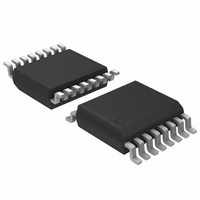ADT7483AARQZ-R7 ON Semiconductor, ADT7483AARQZ-R7 Datasheet - Page 13

ADT7483AARQZ-R7
Manufacturer Part Number
ADT7483AARQZ-R7
Description
IC TEMP SENSOR/ALARM 2CH 16-QSOP
Manufacturer
ON Semiconductor
Datasheet
1.ADT7483AARQZ.pdf
(24 pages)
Specifications of ADT7483AARQZ-R7
Function
Temp Monitoring System (Sensor)
Topology
ADC, Comparator, Multiplexer, Register Bank
Sensor Type
External & Internal
Sensing Temperature
-40°C ~ 125°C, External Sensor
Output Type
SMBus™
Output Alarm
Yes
Output Fan
Yes
Voltage - Supply
3 V ~ 3.6 V
Operating Temperature
-40°C ~ 125°C
Mounting Type
Surface Mount
Package / Case
16-QSOP
Full Temp Accuracy
+/- 2.5 C
Digital Output - Bus Interface
Serial (2-Wire)
Maximum Operating Temperature
+ 125 C
Minimum Operating Temperature
- 40 C
Lead Free Status / RoHS Status
Lead free / RoHS Compliant
Table 10. Conversion Rate/Channel Selector Register
Bit
7
6
<5:4>
<3:0>
Limit Registers
The ADT7483A has three limits for each temperature channel:
high, low, and THERM temperature limits for local, Remote 1,
and Remote 2 temperature measurements. The remote temperature
high and low limits span two registers each to contain an upper
and lower byte for each limit. There is also a THERM hysteresis
register. All limit registers can be written to and read back over
the SMBus. See Table 8 for details of the limit registers’ addresses
and their power-on default values.
When Pin 13 is configured as an ALERT output, the high limit
registers perform a > comparison while the low limit registers
perform a ≤ comparison. For example, if the high limit register
is programmed with 80°C, then measuring 81°C will result in
an out-of-limit condition, setting a flag in the status register. If
the low limit register is programmed with 0°C, measuring 0°C
or lower will result in an out-of-limit condition.
Exceeding either the local or remote THERM limit asserts
THERM low. When Pin 13 is configured as THERM2,
Mnemonic
Averaging
Reserved
Channel
Selector
Conversion
Rates
Function
Setting this bit to 1 disables averaging of the temperature measurements at the slower conversion rates
(averaging cannot take place at the three faster rates, hence, setting this bit has no effect).
Default = 0 = averaging enabled.
Reserved for future use. Do not write to this bit.
These bits are used to select the temperature measurement channels.
These bits set how often the ADT7483A measures each temperature channel.
Conversions/second
0000 = 0.0625
0001 = 0.125
0010 = 0.25
0011 = 0.5
0100 = 1
0101 = 2
0110 = 4
0111 = 8 = default
1000 = 16
1001 = 32
1010 = continuous measurements
00 = round robin = default = all channels.
01 = local temperature.
10 = Remote 1 temperature.
11 = Remote 2 temperature.
Rev. 1 | Page 13 of 24 | www.onsemi.com
Time (seconds)
16
8
4
2
1
500 m
250 m
125 m
62.5 m
31.25 m
exceeding either the local limit or remote high limit asserts
THERM2 low. A default hysteresis value of 10°C is provided
that applies to both THERM channels. This hysteresis value may
be reprogrammed to any value after power-up using Register
Address 0x21.
It is important to remember that the data format for temperature
limits is the same as the temperature measurement data format.
Thus, if the temperature measurement uses the default (binary),
then the temperature limits also use the binary scale. If the
temperature measurement scale is switched, however, the
temperature limits do not automatically switch. The user must
reprogram the limit registers to the desired value in the correct
data format. For example, if the remote low limit is set at 10°C
and the default binary scale is being used, the limit register
value should be 0000 1010b. If the scale is switched to offset
binary, the value in the low temperature limit register should be
reprogrammed to be 0100 1010b.
ADT7483A










